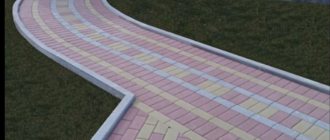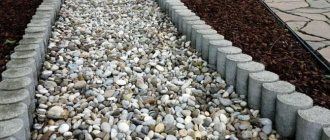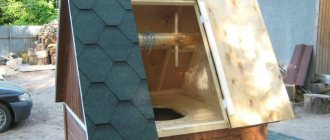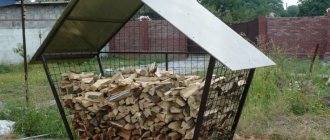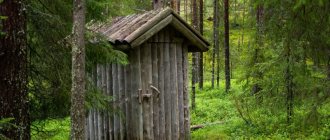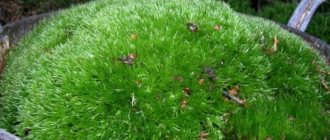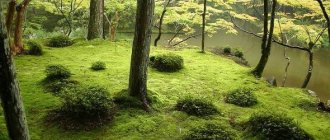Flower beds with crushed stone began to appear here relatively recently. But landscape designers quickly realized all their advantages. You can set up such a front garden on any site. It is not afraid of shadow and bright sun, poor dry or marshy soil. And you can easily make such a flowerbed with your own hands.
At the Soil Trucks company you can buy crushed stone for flower beds with delivery to your site at the lowest price.
Price for crushed stone for flower beds from 490 rubles. for 1m3 Order
In this article you will learn how to choose the right crushed stone for a flower bed. We will talk about the materials, the technology for making such a flower bed, the advantages and disadvantages, as well as how to properly care for such a flower bed and what materials can be used instead of crushed stone.
Let's start with the main thing.
Where is it used?
Decorative crushed stone and decorative gravel are universal materials used to solve many problems in the field of landscape design. In particular they are used for:
- creating unique colorful compositions;
- for the production of individual decorative elements and paving slabs;
- pouring mosaic areas;
- arrangement of embankment paths and platforms;
- mulching the soil;
- decorating the banks and filling the bowls of artificial reservoirs (through the use of waterproof paint);
- creation of small architectural forms;
- production of decorative plaster;
- arrangement of a blind area around a country house and outbuildings;
- framing monuments and obelisks;
- creating alpine slides;
- imitation streams (dry stream);
- installation of decorative concrete fences.
A dry stream made of natural painted stones is an excellent alternative to a waterway Source novogran.com.ua
Scope of application
Colored stone for landscape design is used to create colorful designs in flower beds and to decorate recreation areas. It is also used to create original inscriptions on pedestrian paths. With the help of decorative miniature stones they perform:
- retaliation around the house, pool or gazebos;
- paths on children's playgrounds;
- features on the bottom of ponds;
- framing garden sculptures, monuments.
Decorating benches with gravel and the area around planted ornamental trees looks original.
Advantages
They choose colored crushed stone for landscape design because this building material has a number of advantages:
- ample design possibilities;
- a wide range of materials offered (fractions and colors);
- long service life of compositions created using decorative crushed stone for the garden;
- environmental Safety;
- operational safety for people, which is important for arranging paths and playgrounds, including playgrounds for children;
- if necessary, the backfill of colored gravel can be easily removed; a shovel and a container for transferring the rock are sufficient;
- the appearance of a composition using painted stones is easy to update and refresh;
- sprinkling decorative stones on lawns and flower beds prevents the top layer of soil from drying out and prevents weeds from growing;
Mulching lawns makes it possible not only to decorate them, but also to prevent the growth of weeds Source sochimart.ucoz.com
- possibility of repeated use;
- under the influence of moisture, ultraviolet radiation, low and high temperatures, painted crushed stone retains its attractiveness for a long time;
- compositions made of painted gravel do not require any maintenance other than removing sprouting plant shoots and periodically leveling the surface (in case someone accidentally steps on it).
See also: Catalog of companies that specialize in landscape design of sites.
What else is worth paying attention to
Many characteristics that are of key importance when purchasing crushed stone are unimportant when designing flower beds. These are, for example, grades for crushability, abrasion, and adhesion. After all, in flower beds the material will not be affected by static and dynamic loads; it is not mixed with cement and other fillers.
You should only pay attention to:
- Frost resistance Crushed stone in flower beds will be outdoors all year round. Therefore, it is important for it to take into account the frost resistance indicator (or the number of cycles of freezing and thawing of the material). After all, in winter, under the influence of frost, weak rock can gradually collapse. To prevent this from happening, you should buy material with a frost resistance rating of at least F50 (50 cycles). Crushed stone from our quarries has a frost resistance rating of F100 and higher.
- Radioactivity To be used in a residential area, crushed stone must have a natural radioactivity index of no higher than 370 Bq/kg. Materials with technogenic contamination are not found in our area. All crushed stone that we have for sale is completely safe and has radioactivity up to 265 Bq/kg and below.
Also note that some types of crushed stone can change the pH (acidity) of the soil. For example, granite acidifies the soil, and limestone (to a lesser extent marble) alkalizes it. Therefore, if you want to plant rhododendron, heather, fern, rose, peonies, it is better not to line the flowerbed with limestone material. It will be more useful on soils that are too acidic to normalize the pH.
What happens
Before painting crushed stone for landscape design, they usually consider the possibilities of natural colors of the stone. They allow you to lay the foundation for a future composition; the filling of colored crushed rock is the final stage of decorating the space of a summer cottage. In particular, the natural rock used for decoration has the following shades:
- marble - blue-white, white, black, pink, honey;
- flint - red and pink;
- jasper - sealing wax;
- serpentine - a mixture of greenish-yellow and dark green;
- quartzite - golden, milky beige, crimson, olive;
- gravel - predominant black and gray shades.
Natural jasper has many interesting shades; it can be used in combination with colored rock Source kamenkirpich.ru
Painted crushed rock (granite or marble) has brighter shades that distinguish it from natural: red, gray, green, orange, blue, yellow, pink, etc. For decoration, stone of fractions 5-10, 5-20, 10-20, 20-40 mm is usually used.
In addition, painted stone can vary in such parameters as flakiness (ideally up to 15%), frost resistance, degree of abrasion, compressive strength, density, specific activity of radionuclides. The radiation value must be confirmed by an appropriate certificate.
The cost of decorative material is about:
- from 4,500 rubles per ton of unpainted natural stone;
- from 30 rubles per kilogram of painted stone;
- from 20 rubles for tumbled (stone subjected to abrasive processing);
- from 900 rubles per ton of decorative sand.
Where does colored crushed stone come from?
The production of such decorative material, which is widely used to decorate various areas on the site, began recently. To give gravel a suitable shade, coloring pigments are used; they must withstand the harmful effects of the environment well. The standard choice is polymer dyes that come in a variety of colors. They are chosen because of their positive properties, which are important for such use: non-toxic, cannot come into contact with the soil, and does not negatively affect plants.
To give gravel a suitable shade, coloring pigments are used; they must withstand the harmful effects of the environment well.
How it is made
Stone chips of a certain fraction and acrylic paint are used as raw materials for the manufacture of the material. If the initial raw material is stone chips not sorted into fractions, then the first technological stage will be separation into fractions by sifting on a vibrating screen (vibrating screen).
The necessary raw materials for the production of painted crushed stone are extracted from the quarries Source avistd.ru
The next stage is painting, for which a painting hopper is used, the principle of which is similar to a concrete mixer. The volume of paint loaded into it is about 20% of the volume of loaded crushed stone. After coloring, the crushed stone is moved to a drying chamber; after drying, the stone is packaged in bags weighing from 2 to 20 kg.
There is a risk of purchasing low-quality decorative material. These are mainly products of small enterprises, which, at the expense of quality, can save on:
- feedstock;
- the amount of paint placed in the hopper;
- drying chamber (drying is carried out simply in air on plastic film).
Rules for laying decorative crushed stone
The first operation is marking out the territory on which the composition will be created using painted crushed stone. This is done with the help of pegs and rope, which are stretched, connecting the pegs into one geometric figure (square, rectangle, polyhedron).
Technologies for arranging dacha areas are constantly being improved, and decorating them with painted gravel is no exception. Source luxrico.com
If you plan to arrange a round platform, then you can apply the principle of a compass. To do this, a stake is driven into the center of the future circle, a cord is put on it, and a can of spray paint is tied to the free end of it. Using a spray can, a circle of the desired diameter is drawn.
On a marked area of the terrain, a layer of naturally formed soil is removed to a depth of 10 cm. Restrictions are laid along the outer boundaries of the territory: tape, curbs, natural stones, boards, metal or plastic strips, corners, etc. Depending on the type of limiter chosen, its installation can be carried out either directly on the ground with leveling, or on a prepared cement-sand cushion.
Creating compositions from painted gravel requires not only knowledge but also a certain taste Source volgograd.stroyportal.ru
A layer of sand 5 cm thick is poured onto the surface inside the figure from the limiters. It is compacted and spilled with water to prevent shrinkage. An alternative and more fundamental option is to install a concrete screed on a sand bed. The next layer is a waterproofing material; after laying it, another layer of sand 3 cm thick is poured.
If you plan to create any kind of design inside a figure, then first limiters are placed inside it. The final stage is filling and leveling the decorative colored rock. The usual consumption of crushed stone per 1 square meter when laid at a thickness of 2 cm is about 2 kg. In the case of arranging a site or path using decorative crushed stone on which people will walk, the thickness of the main layer of sand increases to 7-10 cm, crushed stone also to 7-10 cm.
Caring for stone chips in the garden
Caring for the material is quite difficult; it crumbles during use, so periodically you need to put it back in place. Under the influence of wind and other factors, particles fly apart, so if a drawing was created, it will need to be adjusted. Once a year, it is recommended to collect all the gravel, wash it with a hose, and re-lay it after drying.
Once a year, it is recommended to collect all the gravel, wash it with a hose, and re-lay it after drying.
Colored crushed stone is an excellent option to decorate your site; the variety of colors and the ability to create various design ideas from it make its use very popular. But caring for them requires effort and time.
Song examples
Smooth transition from anthropogenic, man-made objects (log house, concrete path) to living nature Source market.sakh.com
The St. George Ribbon, familiar to every Russian, can be easily made from painted rock Source better.by
Alpine motifs are associated with some Western European country Source zagorod-dom48.ru
Final conclusion
Using painted gravel in your landscaping is an easy and inexpensive way to beautify your yard. Moreover, from crushed stone you can create not only compositions for decoration, but platforms and paths along which people will walk. The only condition for obtaining the required result is the purchase of stones that have the required parameters and compliance with the technology when laying gravel. It is better to entrust the choice of material and its installation to specialists.
Ratings 0
Types of stone chips
The most popular types are granite, limestone and gravel. They differ in the density properties and sizes of the resulting particles. A “secondary” type is also distinguished; it is produced by obtaining it from construction waste.
In addition, for some types of construction work, the so-called “screening” is used. It contains a small amount of sand mixed with small fractions of gravel; the price of this type is low.
The most popular types are granite, limestone and gravel.

